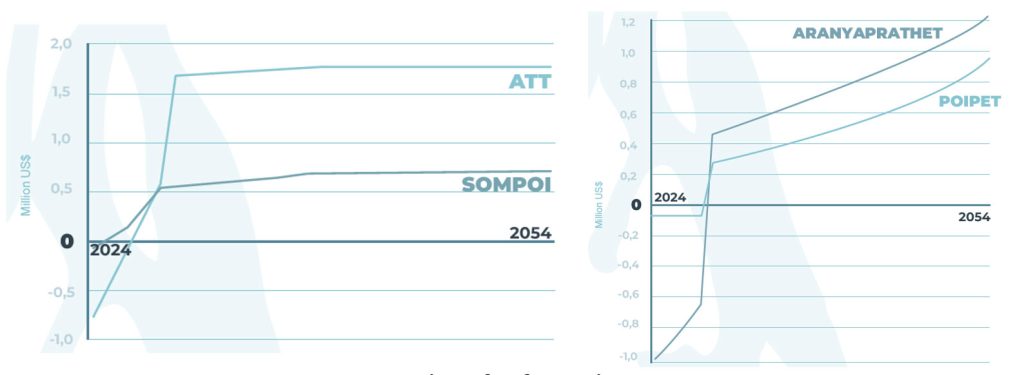Khmer Times, Sept 2023: Throughout the Cambodian province Banteay Meanchey, it was reported that more than 6,000 families have been affected by the severe flood […] It was also reported that after some provinces in Thailand were also hit with floods, the water from those floods began to drain into Banteay Meanchey.

To address transboundary water challenges, Cambodia and Thailand established a partnership to jointly manage flood and droughts facilitated by the Mekong River Commission (MRC) with the support from GIZ and funding from the German Cooperation.
In the jointly by the two countries developed Flood and Drought Master Plan for the shared river basin, Nature-based Solutions (NbS) have become formulated as a key output. Most investment in both countries goes to conventional infrastructure such as reservoirs, irrigation systems, dams, and transport, which in turn suffers from increasing watershed erosion, sedimentation, and flood damage. Therefore, initial conceptual designs for NbS projects have been selected for different landscapes (rural, urban, headwater) to illustrate how NbS can be implemented within the national and regional context and to demonstrate their efficacy in addressing the challenges of floods and droughts.

The overall goal is to replicate, upscale and roll out these NbS across the shared basin as a connected network so that their cumulative impact will substantially reduce the risks of flood and drought. To facilitate this upscaling, an economic analysis of the planned NbS measures was conducted to establish the economic benefits of NbS for flood and drought resilience and highlight the economic case for investments.
This was developed in cooperation with the global Economics of Land Degradation (ELD) Initiative, hosted by GIZ. The ELD Initiative makes the values of land count to inform, promote, and scale land solutions for transformative change.

The cost-benefit analysis presents a robust economic case for further investment in NbS. In rural areas a catchment rehabilitation via NbS was associated with anticipated core benefits for improved water availability and reduced operational costs of reservoirs; in urban areas river rehabilitation and urban greening was associated with core benefits in flood reduction. But additional co-benefits go beyond these objectives. In rural areas, NbS can help with carbon sequestration, biodiversity, fisheries production, and Non-Timber Forest Products (NTFPs), contributing to community livelihoods. In urban areas, NbS can improve air quality, temperature, and recreation, contributing to cost savings and community well-being.


While some benefits of NbS result in immediate, tangible financial gains like the provision of additional irrigation ponds or the prevention of financial losses from flood damages, certain benefits like carbon sequestration may not yield immediate financial benefits. In rural areas, a payment for ecosystem services scheme could increase the financial gains. In urban areas, NbS measures should be considered as part of the land use planning process to protect and enhance green areas. At the same time there is a strong case for more effective property taxation to allow more of the economic benefits of public interventions and investments to be captured by municipal authorities and enable the sustainable management of NbS.
At present climate change has not been considered in the economic analysis, but it is likely to strengthen the economic case of NbS. More intense rainfall events exasperating issues with erosion, sedimentation, and flooding, and expected rainfall variability could seriously effect crop production. In urban areas more intense rainfall events are likely to exasperate current issues with both pluvial and fluvial flooding, and ambient higher temperatures are likely to affect urban livability, human health and cooling demand.

Link to Further Materials
9C9T Atlas (mrcmekong.org)
Contact Person
Nike Minna Hestermann
Key Buzzwords
Nature-based Solutions, Economic Analysis, Ecosystem Services, Flood, Drought, Climate Change Adaptation, Cambodia, Thailand, Mekong River Commission
